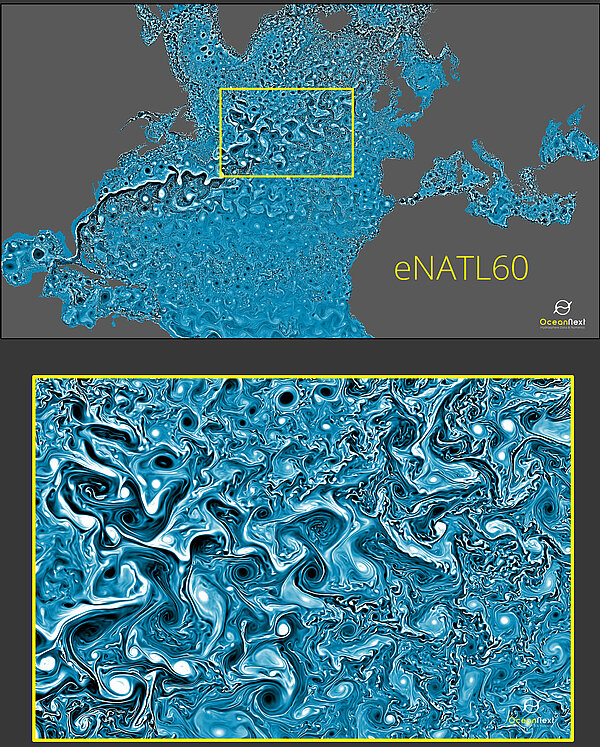Simulating the North Atlantic ocean turbulence at one kilometer-scale
Image of the Month - November 2018
Kilometric-scale oceanic flow features, aka submesoscale turbulence, are known for their importance in regulating the Earth’s climate, as part of the global ocean circulation. To achieve a better understanding of their contribution, realistic numerical simulations of the full 3D oceanic flow in the North Atlantic basin, at ultra-high horizontal and vertical resolution, have been designed. They are currently performed by Ocean Next in close collaboration with the MultiscalE Ocean Modelling (Meom) team at Institut des Géosciences de l'Environnement (IGE, Grenoble, France) in the frame of the project ReSuMPTiOn (Revealing SubMesoscale Processes and Turbulence in the Ocean), led by Ocean Next. The experiment developed in that objective, eNATL60, is a ~1 km resolution horizontal grid setup on 300 vertical levels based on the Nemo ocean model, with the inclusion of tidal motions.
This type of ultrahigh resolution ocean flow simulations has only been made achievable recently thanks to the capability improvements of modern supercomputers. The output set of simulations will provide the ocean/climate community with a pioneering dataset for studying the interactions between fine-scale features and the larger-scale components of oceanic flow. It will also be used to prepare upcoming satellite missions, including the Swot altimetry mission. Swot will observe the surface ocean dynamics at an unprecedented fine-scale resolution. The present project will allow to develop a system ready to simulate, assimilate, interpret, and further expand (including below the surface) the information that will be obtained from Swot.
The Swot high spatial resolution altimetric satellite observations, combined to this set of ultra-high ocean simulations, should lead to major breakthroughs in our understanding of the roles played by fine-scale ocean turbulence (and tidal motions) in influencing the large-scale ocean circulation, and thereby the climate system. The simulations of this project will also be used as a testbed for designing the next generation of models for the Copernicus Marine Environment Monitoring Service.
Acknowledgements
Prace is acknowledged for awarding Ocean Next access to MareNostrum at Barcelona Supercomputing Center (BSC), Spain.
Animation of relative vorticity of hourly surface current over the whole North Atlantic, and over the area framed above (Credits Ocean Next)
See also:
- Applications: oceanography / operational oceanography
- Applications: Oceanography / submesoscale circulation
- Missions: Swot
Other websites on this subject:
- Prace
- Ocean-Next
- https://www.nemo-ocean.eu/
- https://www.bsc.es/marenostrum/marenostrum
- https://www.mercator-ocean.fr/en/science-publications/glorys/
References:
- Le Sommer, J., J.-M. Molines , A. Albert, L. Brodeau, A. Ajayi, L. Gomez Navarro, E. Cosme, T. Penduff, B. Barnier, J. Verron, P. Brasseur, P. Rampal and E. Chassignet. NATL60: A North Atlantic ocean circulation model dataset based on NEMO for preparing SWOT altimeter mission. In preparation for Geoscientific Model Development.





